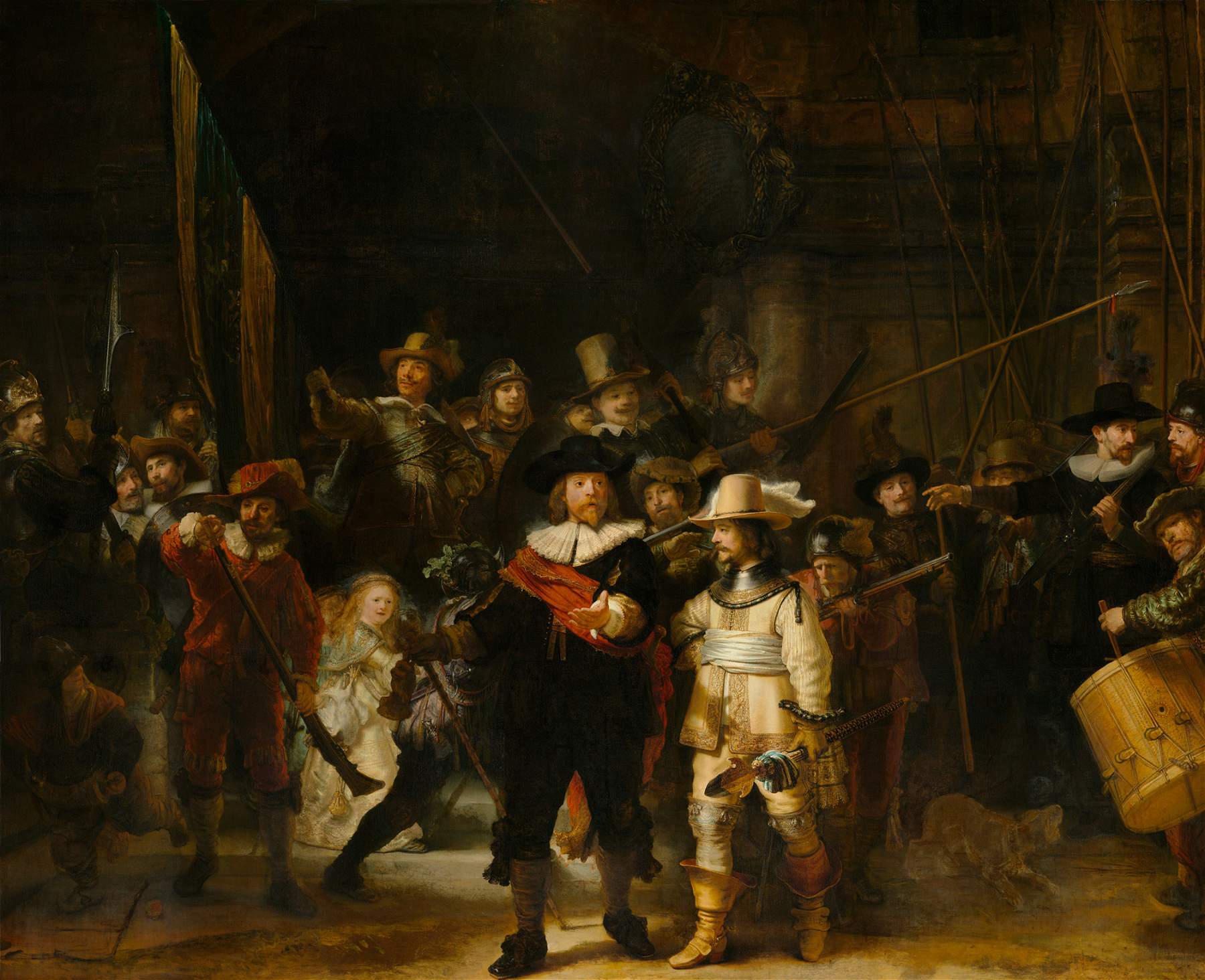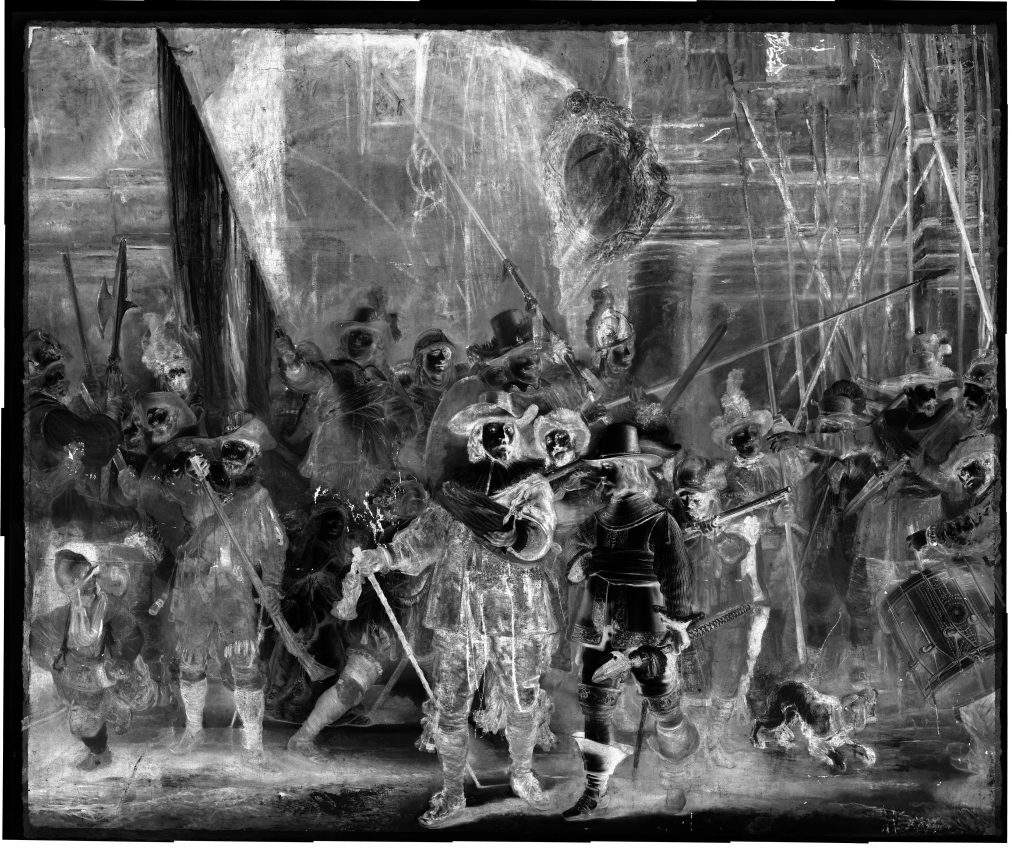Preparatory drawing under the Night Watch, Rembrandt's masterpiece, discovered
Investigations currently underway into the Night Watch, the masterpiece by Rembrandt van Rijn (Leiden, 1606 - Amsterdam, 1669) created in 1642, which is kept at the Rijksmuseum in Amsterdam and has been undergoing restoration for the past two years, have revealed the work’s preparatory drawing, which until now was unknown. The drawing gives us a better understanding of Rembrandt’s spontaneous approach to composition, which was drawn by him directly onto the canvas. The artist applied a brown background and used a beige paint with a high chalk content for his drawing. To date, no other paintings by Rembrandt prepared with this type of paint have been discovered.
Rembrandt probably spent much time searching for the ideal composition for his Night Watch. Previous studies of the painting had already revealed dozens of pentimenti and modifications made by the artist himself. Now researchers have gone further, and using the latest imaging techniques, new discoveries have been made. For example, it was observed how Rembrandt originally executed some feathers on the helmet of soldier Claes van Cruijsbergen, but later repainted them. The artist also changed the position of Rombout Kemp’s leg: numerous scans revealed that the leg was originally painted in a different position. There are also indications of the presence of an additional sword between the captain and lieutenant, and it is now clear that Rembrandt originally envisioned more spears above the soldiers.
Moreover, these analyses have not only provided a fuller understanding of Rembrandt’s working method-the research has shed much light on the current condition of the painting. In many areas of the Night Watch, the painting is still in an excellent state of preservation (for example where Willem van Ruytenburch’s richly decorated coat). Other areas, however, are in poor condition, in part because of the many treatments to which the Night Watch has been subjected since the 17th century: it is more than likely, for example, that the removal of paint in the past has led to paint dissolution in some places. One of the areas showing signs of deterioration is centered on the dog. At the beginning of the restoration of the Night Watch, it was thought that the white halo on the dog was caused by the formation of crystals in the paint. Extensive research has revealed, however, that friction in this part of the painting has led to greater exposure of this area, with the result that the outlines of the dog are now much clearer than Rembrandt originally intended. Another example of deterioration is the disappearance of the cloud of smoke behind Frans Banninck Cocq’s head. The copy of the Night Watch attributed to Gerrit Lundens clearly shows a small column of smoke resulting from the firing of a musket, but only traces of it remain in Rembrandt’s work. Other areas of the canvas showing signs of wear include Frans Banninck Cocq’s costume, which now lacks detail, and the face of the musketeer to his left dressed in red, Jan van der Heede.


Research has also shown that the color was originally more vivid in some parts of the Night Watch. This discoloration is the result of a natural process of degradation and is unfortunately irreversible. In some places, layers of older paint applied in the past have caused a gray glaze, and some of the old retouching done after Rembrandt’s time has also discolored. In any case, collaboration with AkzoNobel, the lead partner in Operation Night Watch, has made it possible to resolve doubts and questions as intricate as those surrounding Rembrandt’s famous impasto technique. Indeed, Rembrandt applied thick varnish to the canvas to achieve a striking three-dimensional structure that reflects light in a unique way. Restorers, thanks to new studies, have succeeded for the first time in replicating Rembrandt’s impasto painting by systematically testing variations of painting formulas using ingredients that were available to Rembrandt, such as white lead, linseed oil, and egg white.
Anyone looking at the Ronda at night today will notice several clearly defined ripples in the upper left corner of the canvas. These deformations, as far as we know, developed earlier this century when the painting was hung in the Phillips Wing during the renovation of the museum’s main building. They probably resulted from excessive weather fluctuations in the gallery during this period. These deformations need to be addressed and can be resolved without any danger to the painting. The treatment will then begin on January 19, 2022l Once this phase of the work is completed, Rijksmuseum conservators will take a step-by-step approach to deciding whether to carry out further conservation treatments.
“The discovery of the drawing,” said Taco Dibbits, director of the Rijksmuseum, “represents a breakthrough in this research. We always suspected that Rembrandt drew directly on the canvas before he tried his hand at this incredibly complex composition, but we didn’t have the evidence. Now we are able to look beneath the pictorial surface better than ever before and we have the evidence, which gives us for the first time a full understanding of how the painting was made. And it is fascinating to see Rembrandt searching for the right composition. We have discovered the genesis of the Night Watch.”
“Each new detail,” says Petria Noble, head of painting conservation at the Rijksmuseum, “gives us another insight into Rembrandt’s creative process: his original idea, his thought processes, and his material and artistic choices. An all-encompassing approach like this would have been impossible even a few years ago, which means that Operation Night Watch is setting a new standard for the study of painting. All these discoveries now prompt us to look at Rembrandt’s other paintings with different eyes: we now know what we should be looking for.”
Alongside AkzoNobel, the Rijksmuseum’s research team is working together with several others, including the Netherlands Agency for Cultural Heritage (RCE), Delft University of Technology (TU Delft), the University of Amsterdam (UvA), the Medical Centers of the Universities of Amsterdam (AUMC) and Antwerp (UA), Wageningen University & Research (WUR), Eindhoven University of Technology (TU/e), Vrije Universiteit Amsterdam (VU), and the National Gallery of Art in Washington DC. Operation Night Watch is made possible in part by The Bennink Foundation, CL de Carvalho-Heineken, PACCAR Foundation, Piet van der Slikke & Sandra Swelheim, American Express Foundation, Familie De Rooij, Het AutoBinck Fonds, TBRM Engineering Solutions, Dina & Kjell Johnsen , Familie D. Ermia, Familie M. van Poecke, Bruker Nano Analytics, Henry M. Holterman Fonds, Irma Theodora Fonds, Luca Fonds, Piek-den Hartog Fonds, Stichting Zabawas, Cevat Fonds, Johanna Kast-Michel Fonds, Marjorie & Jeffrey A. Rosen, Stichting Thurkowfonds, Familie Van Ogtrop Fonds, The Night Watch Fund, the City of Amsterdam, and Amsterdam Museum. Additional resources have come from government funds, contributions from the business community, and donations, bequests, and handouts from friends, which, the museum points out, are and will always remain essential to the Rijksmuseum.
 |
| Preparatory drawing under the Night Watch, Rembrandt's masterpiece, discovered |
Warning: the translation into English of the original Italian article was created using automatic tools. We undertake to review all articles, but we do not guarantee the total absence of inaccuracies in the translation due to the program. You can find the original by clicking on the ITA button. If you find any mistake,please contact us.





























